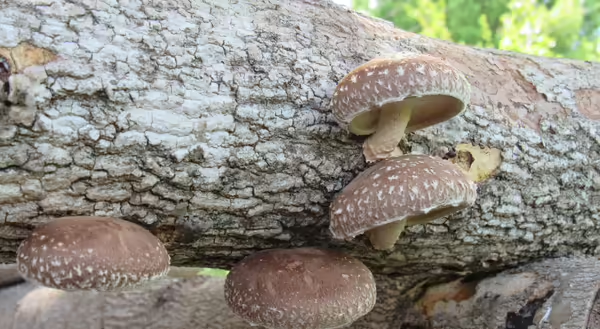
Shiitake mushrooms are a world-renowned delicacy that are beloved by food enthusiasts. Their rich, earthy, umami flavor and meaty texture make them a sought-after ingredient in countless dishes. But did you know that you can easily cultivate these gourmet mushrooms in your own backyard?
Selecting the Right Logs
The first step in cultivating shiitake mushrooms at home is to choose the right type of logs. The sugar maple is the best quality wood that is most available and least threatened as a species in Central Illinois. It is ideal for shiitake cultivation. Ask your local arborist or tree care expert where to get fresh-cut maple logs. When cutting or selecting pre-cut logs, look for ones that are about 4 to 6 inches in diameter, no more than 3 feet long, and free from decay or disease. For optimum results, they should be no older than 4 months, and should be kept out of the sun and wind prior to use.
Drilling the logs
Once logs have been sourced, it's time to prepare them for inoculation. Inoculation refers to the placing of mushroom spawn inside the log. It’s important to get the spawn into the log so that spores in the spawn germinate, grow mycelium, and begin consuming the log from the inside out.
Drill holes into the logs with specialized tools in a diamond pattern, with holes about 4-6 inches apart from each other. Holes should be about 1 inch deep and slightly smaller in diameter than the spawn plugs. The necessary tools for the job are available for sale through several major mushroom cultivation companies online, and there are options for the cost-conscious as well as the production minded.
Inoculating the logs
Once holes are drilled in logs, the next step is inserting shiitake mushroom “spawn”, either in the form of mycelium-covered wooden plugs (plug spawn), or inoculated sawdust spawn. For this job, thumb-trigger inoculation tools or rubber mallets are used to place or hammer in chosen spawn. The spawn can be purchased locally or online, but fresh and high-quality spawn is crucial for a successful spawn run. Once logs are drilled and inoculated, they must be sealed with melted food-grade wax to prevent contamination and drying out of spawn.
Log aftercare – very important
After inoculating the logs, stack them tightly lengthwise in a shaded, moist area under a tree. Ideally, this same location should receive regular rainfall, or weekly watering. For the best results, cover the log stack with a "fruiting blanket" or an old bed sheet from a mushroom supply company for the first 4-6 months or more. This will allow a quick, successful spawn run for the shiitake mycelium now inside the log. Be sure to keep the logs well-watered during hot, dry weather.
Harvesting Your Mushrooms
After about 6 to 12 months, depending on environmental conditions, the shiitake mycelium will have fully colonized the logs and will begin to produce mushrooms. After 6 months, check your logs weekly. Small, brown pinhead mushrooms will begin to emerge from waxed-over inoculation holes. At that point, logs should be stacked in a Lincoln-log style or low A-frame style to allow space for mushrooms to fruit.
To harvest the mushrooms, simply twist them gently off the logs or cut them with a sharp knife. Be sure to harvest the mushrooms when they are still firm and before they start to release spores, as this will ensure the best flavor and texture.
Keep them in a humid, shaded environment and water them during dry periods for productive years of shiitake mushroom harvests to come.
Reach out to your local Extension Educator with questions about sourcing tools and materials to do this yourself at your own home or small farm!